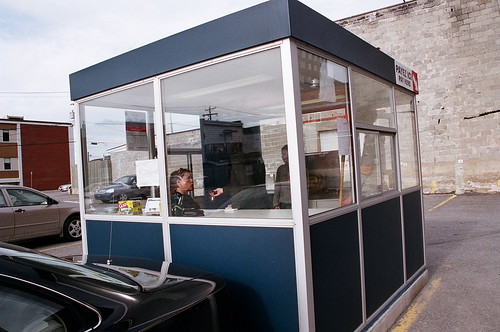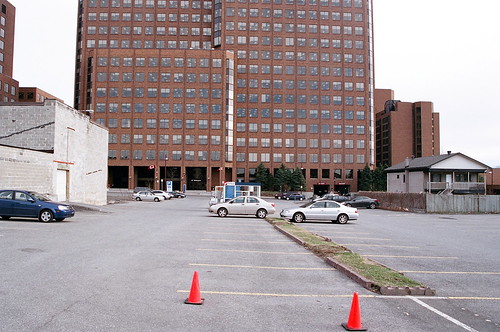
Editor’s Note: Thus continues the investigation into the many parking lots of downtown Hull by Spacing’s Ottawa/Gatineau Region correspondent Amber Yared:
On our third interview for The Impervious P-lot we (Kathy, Malcolm, Michaela, and I) met with Brigitte Ann Epps, an attendant and valet for one of the parking lots behind the brown buildings in Hull. We were excited to talk to someone who would provide an insider perspective on parking lots. To start, I was curious about the small boxy structures parking lot attendants work from, like the one we stood in during the interview. Brigitte told us they are prefabricated in Orillia, Ontario. I wondered what they were called and if they were heated. I imagined attendants freezing all through winter.
B: I call it — well the nicest word it’s ever been called is a “shackâ€. Overall it’s pretty good. We never freeze. We get too hot, mind you, because it’s a greenhouse; we’re surrounded by the sun and the pavement.
Brigitte added that they have two heaters, a microwave, a radio, and a small refrigerator inside. She also told us that the rush of driving a Mustang goes away quickly when you only get to park it; explained the complicated system of keys, tickets, and payment; described one “clunker†that took her fifteen minutes to start each time she had to park it; said that her boss buys the attendants coffee every two weeks; talked about the spiders she had to contend with in a now-demolished shack; recounted how some customers swore they would bike through summer, only to return to driving after a week of cycling; spoke of her concern over providing quality customer service, including phoning clients ten minutes before closing to remind them to collect their keys before she left; and said that, although she loves cars, there is more to life than parking.
The more she talked about her job, the more I was fascinated. Brigitte showed so much respect for parking cars, which she described as “an art form in itselfâ€.
B: It’s really easy to drive a car, but parking cars, totally different story. Patience is a virtue and [a co-worker] had it and he practiced with me for about six months and now I can park a car. I am so proud when a client comes to me, and it’s a man, and he cannot get his car out of his spot, and I can go in and I can move it like that. And it’s just like ‘Yes!’. Because a year ago I would not have been able to do it. And now I’m actually, I’m really good. I mean most people think parking cars is not a big deal, but when you deal with $45,000, $60,000 cars it’s something.

Brigitte happened to be on duty when I went looking for an attendant to set up an interview with. At that time, I had not found anything remarkable in encountering a female valet. As we progressed through the interview, it became clear that Brigitte belongs to a rare species. Of nine lots owned by one company, she is the only female attendant. In talking to her, we had unwittingly stumbled upon the realm of parking gender politics.
B: You can go in a lot of parking lots but you won’t find many women working there ‘cause they don’t like to hire them on principle. I don’t think I have to explain myself; I think we all know why. But I guess they felt sorry for me because I moved here and I couldn’t find a job.
When I started working here it was a big thing. All the truck drivers would come and see me and the other guys from the other parking lots would come and see me and it’s like, “Wow! They actually did hire a girl. Wow! Cool!â€

The parking lot where Brigitte works caters almost exclusively to civil servants who work in the brown buildings. People arrive and, depending on the time of day, park their cars or have a valet park them. Brigitte, whose parking skills are finely honed, is able to distinguish between cars that attendants park and those that customers park themselves. She motioned to one car and said it was crooked in the space.
B: It’s because he parked it himself. We get aggravated with this, especially during the winter because you can’t see the lines. Most people don’t see it. But because we’re so used to it we’ll know we just lost four parking spaces because they did not park between the lines.
It occurred to me that the space conserved by valet parking could help lessen the growth of parking lots in Hull; valets can fit a higher density of cars within a restricted area. Maybe valet parking should be mandatory in all parking lots in Hull.
Amber Yared is one among a group of artists, writers, educators, and architects working on The Impervious P-lot, a Hull-based CUP project about parking lots and what they do besides store cars. She will be posting her findings on the Spacing Toronto and Spacing Montreal as the project progresses.

9 comments
What a flashback — I worked in “the brown buildings” myself one summer during university. I was struck by the vast quantity of stationnement on offer, too, though I took the bus across the river from Ottawa each day.
You can go in a lot of parking lots but you won’t find many women working there ‘cause they don’t like to hire them on principle. I don’t think I have to explain myself; I think we all know why.
Actually, she does. Why?
>thickslab,
I think she was referring to the generalization: women cannot park.
The parking’s not nearly enough, mind you. Lots of people working in those buildings end up parking on the streets and feeding the meters every couple hours. The contrast between what those lots look like during the day versus on the weekends is just unbelievable.
It’s true. Michelle Guitard (the historian we interviewed) even told us that she regularly receives notes from strangers asking to rent her driveway. They leave the notes in her mailbox in Hull.
It seems people will drive even if there aren’t enough parking lots and spaces to accommodate them. I guess they are also hoping to find cheaper options.
People will drive if that is the best option available to them. The huge parking squeeze — compared to the number of cars looking for parking spots — is inconvenient.
But it is not nearly inconvenient enough to make driving less convenient than the alternatives. The Portage buildings are just next to a bridge, it’s true, so there aren’t that many bus routes you could conceivably have. And OC Transpo on the Ottawa side has certainly gotten a lot better over the years.
Still, Ottawa and, certainly, Gatineau, just aren’t set up to get from place to place by bus very conveniently. Add to that the fact that many, even most, civil servants have families, many with kids that need to be driven on the way or on the way back, errands that can only be run at lunchtime, and so forth, and … well, not driving doesn’t make a lot of sense for too many people.
As an example: I lived about a 5 minute walk from those buildings, on Wright St., during the time that I worked for the federal government. But at that time I was single and without children. Were I married with children, then were I to consider wanting to be able to continue to work there, I would have to consider — among other things — whether I wanted to live in a situation where only one type of public school (French) was available for my kids, rather than two (English and French).
There are many other examples, both to do with Ottawa-Gatineau dynamics, and to do with the very car-oriented culture, and small-town/suburban/semi-rural rather than urban culture, that characterises the Outaouais region on the Quebec side. But, well, that example is one of them.
For an interesting contrast, though, consider Wakefield. A useful way of looking at things might be: why can’t downtown Hull go the way of Wakefield? There are lots of answers to that, but I wonder whether many of them can’t be overcome.
Tell us about Wakefield — I don’t know much (anything) about it.
This is a good starting point.
ooohh…need to take some parking skills lessons from these Japanese guys
http://japansugoi.com/wordpress/good-parking-skills-required-in-japa/